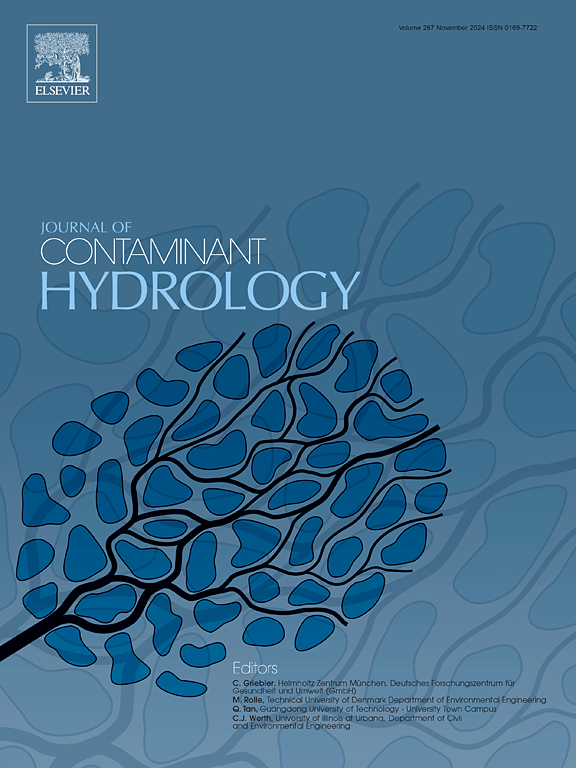Reactive solute transport simulation of multicomponent cation exchange and diffusion processes in column experiments with clay-rich rock
IF 3.5
3区 环境科学与生态学
Q2 ENVIRONMENTAL SCIENCES
引用次数: 0
Abstract
Clays and clay-rich rocks play often an important role in nuclear waste disposal due to their low permeability and high sorption capacity, acting as natural barriers to fluid movement and contaminant migration. Understanding the transport and sorption behaviours of hazardous elements in clay-rich environments is therefore essential for long-term simulations with validated models of experimental data. This study investigates the reactive transport of 17 ionic compounds in the Woodford claystone using both experimental and modelling approaches. The experiment was conducted by injecting a multi-tracer solution into a column filled with crushed claystone, employing a flow-interruption method for examining kinetic behaviour during diffusion-dominated mass transfer. TOUGHREACT V4.0 OMP reactive transport code was applied to replicate the tests, using an advective-diffusive single porosity flow model that considers mineral dissolution/precipitation and cation exchange. The modelling results demonstrated that cation exchange and diffusion, along with advection, were the primary processes influencing ionic concentrations in the experiment. The primary mineral dissolution reactions were pyrite oxidation and silicate weathering, releasing Si, Al, and Fe that reprecipitated or contributed to cation exchange. The findings indicated that the claystone sample effectively sorbs Cs, Pb, and Eu through cation exchange. While the model showed good agreement with the experimental data, an excessive diffusion effect was simulated using the single-porosity model, which would likely be less if employing a dual-porosity model and accounting for immobile water.
富粘土岩柱实验中多组分阳离子交换和扩散过程的反应溶质输运模拟
粘土和富含粘土的岩石由于其低渗透性和高吸附能力,作为流体运动和污染物迁移的天然屏障,往往在核废料处理中发挥重要作用。因此,了解危险元素在富含粘土的环境中的迁移和吸附行为对于使用实验数据的验证模型进行长期模拟至关重要。本研究使用实验和模型方法研究了伍德福德粘土岩中17种离子化合物的反应性迁移。该实验通过将多示踪剂溶液注入充满粘土碎石的柱中进行,采用流动中断方法来检测扩散主导传质过程中的动力学行为。采用考虑矿物溶解/沉淀和阳离子交换的平流-扩散单孔隙流动模型,应用TOUGHREACT V4.0 OMP反应输输程序重复测试。模拟结果表明,阳离子交换和扩散以及平流是影响实验中离子浓度的主要过程。主要的矿物溶解反应是黄铁矿氧化和硅酸盐风化,释放出Si、Al和Fe,这些Si、Al和Fe再沉淀或促进阳离子交换。结果表明,粘土岩样品通过阳离子交换有效吸附Cs、Pb和Eu。虽然模型与实验数据吻合较好,但单孔隙度模型模拟的扩散效应过大,如果采用双孔隙度模型并考虑不动水,扩散效应可能会小一些。
本文章由计算机程序翻译,如有差异,请以英文原文为准。
求助全文
约1分钟内获得全文
求助全文
来源期刊

Journal of contaminant hydrology
环境科学-地球科学综合
CiteScore
6.80
自引率
2.80%
发文量
129
审稿时长
68 days
期刊介绍:
The Journal of Contaminant Hydrology is an international journal publishing scientific articles pertaining to the contamination of subsurface water resources. Emphasis is placed on investigations of the physical, chemical, and biological processes influencing the behavior and fate of organic and inorganic contaminants in the unsaturated (vadose) and saturated (groundwater) zones, as well as at groundwater-surface water interfaces. The ecological impacts of contaminants transported both from and to aquifers are of interest. Articles on contamination of surface water only, without a link to groundwater, are out of the scope. Broad latitude is allowed in identifying contaminants of interest, and include legacy and emerging pollutants, nutrients, nanoparticles, pathogenic microorganisms (e.g., bacteria, viruses, protozoa), microplastics, and various constituents associated with energy production (e.g., methane, carbon dioxide, hydrogen sulfide).
The journal''s scope embraces a wide range of topics including: experimental investigations of contaminant sorption, diffusion, transformation, volatilization and transport in the surface and subsurface; characterization of soil and aquifer properties only as they influence contaminant behavior; development and testing of mathematical models of contaminant behaviour; innovative techniques for restoration of contaminated sites; development of new tools or techniques for monitoring the extent of soil and groundwater contamination; transformation of contaminants in the hyporheic zone; effects of contaminants traversing the hyporheic zone on surface water and groundwater ecosystems; subsurface carbon sequestration and/or turnover; and migration of fluids associated with energy production into groundwater.
 求助内容:
求助内容: 应助结果提醒方式:
应助结果提醒方式:


